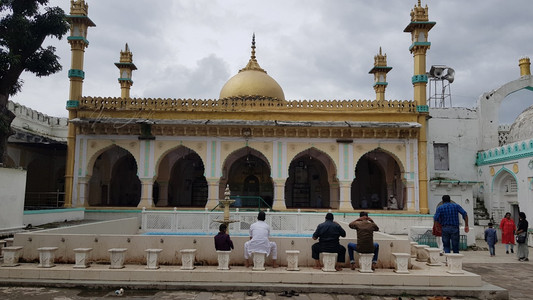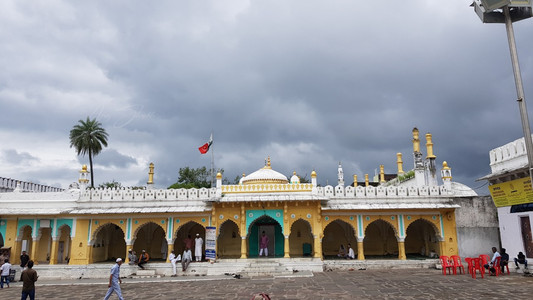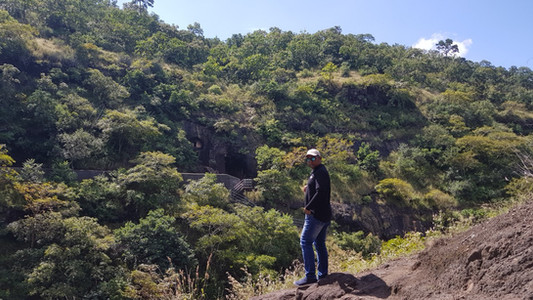Perfect Travel Blueprint For Sambhajinagar (Aurangabad) Backpacking Trip
- Ajaz Shaikh
- Nov 7, 2019
- 18 min read
Updated: Mar 16
Aurangabad laid low through most of the tumultuous history of medieval India and only hit the spotlight when the last Mughal emperor, Aurangzeb, made the city his capital from 1653 to 1707. With the emperor’s death came the city’s rapid decline, but the brief period of glory saw the building of some fascinating monuments, including Bibi-qa-Maqbara - Taj of Deccan, and these continue to draw a steady trickle of visitors.

Alongside other historic relics, such as a group of ancient Buddhist caves, these Mughal relics make Aurangabad a good choice for a weekend excursion from Mumbai. But the real reason for traipsing here is because the town is an excellent base for exploring the World Heritage Sites of Ellora and Ajanta.
Day One: Welcome to Sambhajinagar (Aurangabad) Backpacking Trip
Pack a small bag with must-have things because you will need to walk a lot to explore to the fullest. You may prefer to wear slip-on shoe
1. Let’s talk about the Ajanta Caves
Ajanta Caves have always been recognized as the gems that represent Indian history and the impressive artistry that existed in the foregone era. The Ajanta caves, like the temples of Khajuraho, were “lost” for centuries until an Englishman discovered them in the mid-19th century during his hunting spree. They are all Buddhist and known more for their paintings, which were largely destroyed by water damage. But what remains is impressive enough to make these caves as remarkable as those at Ellora but in a different way.

These magnetic caves got their name from a nearby village, Ajanta. In total, there are 30 caves, including the unfinished ones. Archaeological Survey of India has described it as ‘the finest surviving examples of Indian art, especially painting’. The location of this place provides a calm and composed environment, due to which the Buddhist monks used to meditate at these secluded places. Chinese Buddhist travellers such as Fa Hien and Hiuen Tsang have also mentioned the Ajanta Caves in their memoirs (memoirs - a historical account or biography written from personal knowledge)

It takes around 2-3 hours to explore the caves to their fullest. Peace, serenity or natural bliss, whatever you may need, vacation is gifted by these marvels, the Ajanta Caves. For more details, click here.
Opening Hours and Entry Charges:
Entry charges: INR 40 per person (For Indians)
Timings: 08:00 AM to 06:00 PM (Except Monday)
2. Saptakunda Waterfall
(7 levels of circular small ponds)
I would recommend one to climb the hill which is exactly opposite to the caves and go till the farthest end. From there, one can enjoy the breathtaking views of the Ajanta Caves and the Saptakunda Waterfall.
The waterfall has 7 levels of individual circular small ponds via which water flows before it reaches the Waghora river beneath.
3. Go Beyond Ajanta Viewpoint
Within 30 minutes drive from Ajanta Caves Parking Space, there is Ajanta Viewpoint. The view of the caves of Ajanta lining the dry gorge from this point is astounding. The same panorama teems with an abundance of greenery covering the hills dotted with waterfalls during the monsoons. The river flowing through the gorge at the foot of the caves is called Waghora for the plenty of tigers which roamed around the river (Wagh means Tiger) in ancient times.
The steps descending from the viewpoint and winding through the dry forest area are well-built. Midway, we reached a rocky terrain which offered a closer view of the caves and Satkund on the extreme left beyond cave 28 which is an exceptional waterfall of seven cascades which flows to form the Waghora River.
Earlier tourists used to walk from Ajanta Viewpoint to the caves but due to few wild animals sighted around in the walking path in the past few years. This route is not used any more.
Breakfast & Lunch: Hotel Sai Milan Ajanta
If you are travelling in a private car you must take a halt at Hotel Sai Milan Ajanta for breakfast & lunch. It’s a pocket-friendly place very close to the Ajanta Caves. Must try Masala Omlet with Roti and Non-Veg Chicken Meal. For all chai lovers, you will love this place.
4. Himroo Fabrics/Factory: Offbeat Attraction in Aurangabad
Himroo is a fabric made of silk and cotton, which is grown locally in Aurangabad. Himroo was brought to Aurangabad in the reign of Mohammad Tughlaq, when he had shifted his capital from Delhi to Daulatabad, Aurangabad. The word himroo originated from the Persian word Hum-ruh, which means 'similar'. Himroo is a replication of Kinkhwab, which was woven with pure golden and silver threads in the olden days, and was meant for the royal families.
With basic training, modernized tools and equipment as well as meticulous planning, Aurangabad’s weavers too can diversify and reclaim the market. However, a true lover of the art continues to insist on the woven magic created by human hands.
Day Three: Too many places on the list
I would recommend hiring a rickshaw. If you go hard on negotiation, it will cost you INR 1000 for one full day to see the above places. Pack a small bag with must-have things because you will need to walk a lot to explore to the fullest. You may prefer to wear a slip-on shoe
You need to start your day as early as possible to beat the crowd, and hence, I started my day at 07:00 AM from my hotel. It took me 40 minutes to reach Ellora Caves and another 30 minutes for breakfast at Hotel Kailash next to the entry gate.
5. Exploring Ellora Caves
Dating back to 5th-10th-century C.E., Ellora caves are divided into 3 parts- Hindu Caves, Jain Caves and Buddhist Caves. Unlike Ajanta Caves, Ellora is believed to be visited by enthused travellers and royal personages. Locally named as Verul Leni, Ellora Caves is located on the Aurangabad - Chalisgaon road, 30 km away from Aurangabad city. The cave is the largest single monolithic excavation in the world. One of the interesting parts of Ellora is the caves, which were built out of the volcanic basaltic formation of Maharashtra, also known as Deccan Trap. As you move ahead to explore the caves, you’ll come across a glimpse of channels through which volcanic lava once flowed. The lava further gave rise to horizontal flows with vesicular trap beds.
Ellora was once the trade route connecting the western ports of the Arabian Sea like Kalyan, Chemula and island cities like Paithan, Ter and others. Ellora was excavated in three different forms- Buddhism, Brahmanism and Jainism, dated by the 6th-7th century AD to the 11th-12th AD. Presently, there are 100 caves, out of which 34 are famous tourist spots. Caves 1-12 belong to Buddhist, 13-29 to Brahamanical and 30-34 to Jain.
To explore Ellora Caves, you need a good amount of time. The artistic expression and architectural splendour are worth excavating. If you love investing time in exploring ancient art, then visit Caves no 10, 16, 21 and 32. These caves give a clear glimpse of Buddhism, Brahmanism and Jainism art. It takes around 2 hours to explore the caves to their fullest. For more details, click here.
Opening Hours and Entry Charges:
Entry charges: INR 25 per person (For Indian)
Timings: 06:00 AM to 05:00 PM (Except Tuesday)
6. Most beautiful waterfalls in the world
I would recommend one to go towards cave 25; from there one can enjoy the breathtaking views of Ellora Waterfall.
It was the sheer beauty that mesmerised me. So even a waterfall not very high or not very broad or not so majestic might be among the most beautiful. That’s the reason why a column of water falling right from the top of the Ellora caves at Aurangabad in Maharashtra has been termed one of the most wonderful waterfalls in the world.
7. Grishneshwar Jyotirlinga
Grishneshwar Temple, the twelfth Jyotirlinga of Lord Shiva, is an important pilgrimage site for Shaivites in Aurangabad. Red rocks are mainly used for the construction of the temple, which consists of a remarkable five-tier shikara. Inside the temple is a beautiful display of carving-work of other gods and goddesses. As per beliefs, a staunch follower of Lord Shiva, once found a treasure inside a snake pit and devoted the money to build this temple. Male devotees are only allowed inside the temple without any clothes on the upper part of the body. Cameras are not allowed inside the temple and there are no VIP or privileged entry options inside the temple. Though there any small shops where you can leave your handset safe.
8. Bhadra Maruti - A Lying Hanuman Temple
Bhadra Maruti temple is one of the important places of worship in Khuldabad, Aurangabad. Dedicated to Lord Hanuman, it is visited by devotees as well as tourists. The idol inside the temple is Lord Hanuman in a sleeping posture. It is one among the three temples where the idol of Lord Hanuman is found in a sleeping posture; the other two temples are located in Allahabad and Madhya Pradesh. Every year, the holy site is flocked by several Hanuman devotees from all across the country, mostly during Ram Navami and Hanuman Jayanti. Legends say that, in ancient times, Khuldabad was renowned to be Bhadravati and was ruled by a ruler named Bhadrasena who was a strong devotee of Lord Ram. Once, when Bhadrasena was lost in singing the bhajans of Lord Ram, Lord Hanuman arrived at his place listening to his songs. Lord Hanuman was so happy that he silently took a sleeping pose- a yogic posture called Bhavya Samadhi. After finishing the song, when Bhadrasena saw the Lord in a resting posture, he asked him to bless the site with his presence.
9. Valley of Sufi Saints - Tomb of Mughal Emperor Aurangzeb
(Tomb of Aurangzeb, Tomb of Hazrat Khwaja Shaikh Burhanuddin Gareeb and Dargah Syed Zainuddin Shirazi )
The town of Khuldabad has come to be known as the Valley of the Saints because of the many tomb shrines of the Chishti Sufi masters and saints that adorn the valley’s landscape. The shrine of Moinuddin Chishti of Khuldabad and the shrine of the Sufi saint Muntajib al-Din are located here. Apart from the tomb of the Sufi saints, the valley also hosts the tomb of Aurangzeb, the last great Mughal emperor, the Tomb of Asif Jah, the first Nizam of Hyderabad and the tomb of Tana Shan, the last king of Golconda. Amongst the sprawling green meadows of Khuldabad, the shrines and tombs of the great saints are an inspiration for many travellers who frequent this place in their quest for spiritual realization and inner peace, and experience Sufism in all its dignity and humbleness.
Quite in keeping with his austere tastes, Aurangzeb’s tomb in Khuldabad is a plain, brilliantly whitewashed structure with a large, arcaded courtyard in a typical mix of Islamic and Rajasthani architecture. In striking contrast with the tombs of his forefathers, this has few embellishments save a modest dome or two and minarets. A red signboard reads, Tomb of Mughal Emperor Aurangzeb Alamgeer. It is within the compound of the Dargah Syed Zainuddin Shirazi, and the pathway leading to the inconspicuous entrance is lined with a couple of shops selling flowers, perfumeries and other offerings. Facing it, on the other side of the road, is the white tomb of Hazrat Khwaja Shaikh Burhanuddin Gareeb. This is not the kind of tomb where you expect the Mughal emperor who held sway for the longest period — 50 years — to be interred. Khuldabad is 24 kms from Aurangabad, and several Sufi saints lived here
In Aurangabad, everything is classic and magnificent, even the mausoleums. Zainuddin Shirzai's Maqbara, the mausoleum of the Sufi saint Zainuddin Shirazi, is an example of Mughal architecture and a must-visit for tourists. Zain Uddin died in H. 771, and a handsome mausoleum was erected over his tomb at Roza. Along with Zainuddin Shirazi, here lies the Mughal king Aurangzeb, in a manner he wished, simple and bare. While Aurangzeb chose Khuldabad for himself because it was religiously important, he chose Aurangabad for his wife since it was the royal city. Along with the architecture, what makes this vestige look apart from others is that it features "parahan" (the robe of the prophet) and "taj" given to Burhanu-d din on succeeding to the caliphate, carefully preserved in the wooden box.
10. Daulatabad Fort
(Bharat Mata Temple, Chand Minar, Baradari, Chini Mahal, Mendha Cannon & Daulatabad City Aerial Viewpoint)
Built on a 200 meters high conical hill, it was one of the most powerful Forts of the medieval Deccan. It is considered to be one of the seven wonders of Maharashtra, and you shouldn’t miss it.
The defence system that made Daulatabad virtually impregnable comprised fortifications with double and even triple rows of massive walls. In addition, there are ingeniously built mazes with a complex arrangement of entryways and deep rock-cut moats and trenches which can be crossed only at one point, over a drawbridge. The defence mechanism of the rock-cut subterranean passage is unbelievable.
The fort is one the most complex and intricate forts of Deccan, having the honour of being the capital of Yadavas for over a century (1187-1294), the capital of India during the Tughlaq period (1328), and the Capital of Nizamshahis of Ahmednagar (1607 A.D).
Interesting facts that shouldn’t be missed to be known
Hathi Haud: measures 47.75 m in length, 46.75 m in width and 6.61 m in depth.
Bharat Mata temple: Measures 87.14 m EW and 72.80 m NS with two openings to the east and north.
Chand Minar: Built by Sultan Alau-ud-din-Bahmani (Sultan Ahmed Shah 2) in AD 1447, height of 70 m and circumference of 21 m at the base.
Andheri: A serpentine dark passage used as a defence mechanism which was never conquered.
Baradari: Built in A.D 1636, perhaps for Shah Jahan's visit (A.D 1627-1658), consisting of 13 halls. The building was the favourite summer residence of Emperor Shah Jahan and his son Alamgir Aurangzeb
Chini Mahal: The thought-provoking Chini Mahal is all that remains of Chini Mahal, which is ironically known as the Chinese Mahal. This blue tiled palace was used by Aurangzeb to imprison the last king of Golconda, Abdul Hasan Tana Shah until his death. Now in ruins, the palace was once covered with blue stones, and that's why it was called the Chini Mahal. Chini Mahal marks the entrance of the Daulatabad Fort.
Mendha Cannon: The cannon with the ram’s head is called Mendha Tope as Mendha means ram and tope means cannon in Marathi. One look at the beautiful rear end of the cannon, which is shaped in the form of a ram’s head, will make you ‘baa baa bleat’ with agreement.
It takes around 2 hours to explore the entry fort. Trek to the top of the fort to catch an aerial view of the Daulatabad City and Return. The valley from the most cannon mounted or summit point is stunning and green.
Opening Hours and Entry Charges:
Entry charges: INR 25 per person (For Indian)
Timings: 06:00 AM to 05:00 PM
11. Panchakki (Water Mill) & Dargah Baba Shah Muzafir
Panchakki is a water mill complex consisting of a court, a madrasa, the house of a minister, a mosque, houses dedicated to females and a Sarai. The mill derives its name from the grinding mill used to grind grains for the pilgrims. Surrounded by hues of blue and shades of green, Panchakki is a perfect picnic spot and a much-frequented attraction in Aurangabad.
An underground water stream 6 km away from Panchakki, which is a tributary of the Harsul River, is a source of steady water supply to this structure and is transported through earthen pipes. One can only imagine the pure genius and farsightedness of the construction plan of this marvel. What is noteworthy is that even though the purpose of the building Panchakki was sheer utility, the beauty of it is not compromised in the least. The calm silver waters of the reservoir act like the sky's mirror, and the gentle rhythmic ripples hypnotise the onlooker. There is a huge banyan tree, almost 300 years old, which stands tall by Panchakki, only to add to its brimming magnificence.
Panchakki is also a cenotaph for Hazrat Baba Shah Musafir, who was a spiritual guru and counsellor of Aurangzeb. Originally from Bukhara in Russia, Hazrat Baba Shah Musafir was a well-respected Sufi saint and the founder of Panchakki as well as its library. So, he was buried at Panchakki, and the memorial garden is lined with numerous fish tanks.
By the time you are done with all the places on day two, you must be tired. So have an early dinner and hit the bed because for day three, you need to start early in the morning. For dinner, if you are around Zostel or Kranti Chowk, try Mustafa Dum Biryani (Veg & Non Veg)
Day Four: Incredible Natural Wonders
Prefer to wear trekking shoes if you have one. You need to start your around 5:00 AM
12. Lonar Crater: Incredible and Awe-Inspiring Natural Wonders
(Gaumukh (Gomukh) Temple: Dhara & Kamalji Devi Temple - Dedicated to Padmavati)
Standing at the top of the crater and looking down at this biodiversity bowl is an incredibly cool experience. The forest, the temple ruins, the lake and the funky little town of Lonar all make for an interesting couple of days, one not to be missed.
The crater is located beautifully in the heart of the town. It is a wonderful and magical thing. The lake inside the crater is both alkaline and saline, adding to its mysticism. The freshwater comes from an underground stream. The crater is about 200 metres deep, and it usually takes only 30 minutes to reach the bottom. For more details, click here.
Gaumukh (Gomukh) Temple: Dhara
The entrance gate to Lonar has a temple called Gaumukh Temple (Dhara). Dhara, located at the brim of the crater, is said to be a source of pure and holy water: a small stream, from
where water gets collected into a four-meter-wide shallow artificial pool constructed at the centre of a 5 meters high fort like rectangular structure with steps all sides. Believed to have medicinal value this water is almost like the lifeline of Lonar. Many of the pilgrimage: visitors were happy to get a chance to bathe in the water from the stream.
Kamalji Devi Temple - Dedicated to Padmavati
Kamalja Devi Temple is located beside the lake and also features carved images. Although the water level rises during the rainy season and falls in summer, the temple is located above the water level. It is said the Goddess appeared Swayambhu here.
It takes around 3-4 hours to explore the lake to their fullest. Peace, serenity or natural bliss, whatever you may need, vacation is gifted by these marvels, the Lonar Crater. For more details, click here.
13. Aurangabad Caves
Aurangabad Caves are twelve rock-cut Buddhist shrines located around 20km northwest of Aurangabad. These caves date back to the 6th and 8th centuries and should not be confused with the Ajanta and Ellora Caves, which are also located close to Aurangabad. Carved out of Soft Basalt Rock, these are considered as one of the most spectacular caves in India. Bibi Ka Maqabra and Soneri Mahal are located quite close to the Aurangabad Caves. From the top, a panoramic and breathtaking view of the city is seen.
If you are fond of heritage, then you will love this place of attraction. The Aurangabad Caves are also considered ideal for trekking.
The stunning caves were mostly Buddhist Viharas and are now under the protection of the Archaeological Survey of India. The Aurangabad Caves are divided into three separate groups depending on their location:
First Group: Cave 1 to Cave 5
Second Group: Cave 6 to Cave 9
Third Group: Cave 10 to Cave 12
The first two caves have a distance of 500 metres between them, and the third one is slightly further to the east. The definite attraction of the Aurangabad Caves is its sculptures. They are artificially rock-cut. Caves I and III of Aurangabad and the last caves of Ajanta co-existed, as is apparent from striking parallels
14. Sunehri Mahal
Soneri Mahal was built by a Bandalkand chief who accompanied Aurangzeb into the Dakhan. The Mahal was built between 1651 AD and 1653 AD for INR 50,000, and in 1934 AD, it was sold to the Nizam of Hyderabad for INR 26,400. The Mahal is named after the paintings in the palace that were once painted in gold.
It is a grand two-storey building constructed in typical Rajput style. The palace is made up of lime and stone. Sprawling over two storeys, the palace stands as a testimony of Indian architectural splendour with some intricate decorations all over. A well-manicured garden adds to its beauty. The entrance of the Palace is decorated with beautifully done arches.
Day Five: Last Day in Aurangabad
We have a few things to cover so that we can explore the local market, and you can also use the day to see any left-out place
15. Pithalkhora Caves: Offbeat Attraction in Aurangabad
Pitalkhora Caves are located on the Aurangabad - Chalisgaon Road. One of the earliest caves in Maharashtra, Pitalkhora Caves, is located in Chandora hills, near Bharmarwadi village, Aurangabad district. This 3rd-century rock-cut Buddhist cave complex is the largest group of monuments belonging to the Satavahana Dynasty. Also known as Brazen Glen, the caves are made up of fourteen rock-cut structures which have fine architectural styles and paintings. Out of these fourteen monuments, four are chaityas, and the rest are viharas.
The Pitalkhora Caves date back to the 1st century BC to the 5th century AD. Discovered in 1853 and lesser known as compared to Ajanta and Ellora Caves, these exquisite caves boast beautiful inscriptions of animals and statues of soldiers. They are cut in a variety of basalt rocks. However, some of them are damaged due to climatic conditions. The caves are divided into Group I and Group II. Caves number 1 to 9 come under Group I, and 10 to 14 come under Group II.
A flight of concrete steps has to be climbed past a beautiful waterfall, which makes the sight even more fascinating. Pitalkhora Caves should definitely be on the bucket list if you are looking for a historical expedition.
16. Bani Begum Mahal
Bani Begum Garden is a panoramic garden located very close to Ellora Caves it will fall on the way back from Pitalkhora Caves. The garden is known for its lush green surroundings and comfortable atmosphere.
The garden got its name from the tomb of Bani Begum, the wife of Aurangzeb's son, which is found in the middle of this garden. Fountains, fluted pillars and massive domes can be seen in the garden which is landscaped in the Mughal style and presents architecture of the departed period.
17. Taj Of Deccan: Bibi Ka Maqbara
Bibi Ka Maqbara draws its inspiration from the famous Taj Mahal of Agra, built by none other than Prince Azam Shah’s grandfather, Mughal emperor Shah Jahan, in memory of his wife, Mumtaz Mahal. Azam Shah intended to build a monument that would rival the Taj Mahal.
Unfortunately, he lacked the treasury his grandfather had access to, as well as the skilled labour the treasury bought, resulting in a poor copy of the latter. Even so, Bibi Ka Maqbara is an architectural wonder with intricate designs, carved motifs, an imposing structure and beautifully landscaped Mughal-style gardens. Due to its strong resemblance to the Taj Mahal, it is lovingly called the “Taj of the Deccan”.
18. Gul Mandi Market
Every town has its market and these markets give you a feel of the town. Gul Mandi is the place to go in Aurangabad to get this feel. Spread out, crowded and has a variety of stuff. Good to walk around since many of the roads are not that wide.
Goodbye, Aurangabad - See you later
Before saying final goodbye to the city do try Mustafa Dum Biryani – they serve Veg, Chicken and Mutton Biryani. I loved their Chicken Biryani. After such an amazing biryani, you need a mouth freshener, so you must try Meetha Pan from the famous pan shop of Aurangabad Tara Pan. Both places are located within walking distance from Zostel.
For the Back Home Journey – 17058 Devagiri Express leaving from Aurangabad at 11:20 PM which will reach Mumbai around 07:00 AM the next day.
Good To Know FAQs
How to reach Aurangabad from Mumbai?
The cheapest and most convenient way to reach Aurangabad is via railway. Aurangabad has rail connectivity with major cities such as Delhi, Mumbai, Hyderabad, Nagpur, and Pune. If you are coming from the Northern part of India, you can opt for the Jalgaon railway station. Aurangabad is also very well connected by road from Mumbai. The frequency of buses is quite high, and you can get a bus as early as 5:00 AM. Aurangabad is also connected by Air.
From Mumbai, I took the 12071 Jan Shatabdi Express leaving from Dadar at 02:00 PM, which will reach Aurangabad around 08:10 PM.
Best Accommodation Options for Solo Travelers in Aurangabad
To avoid wasting travel time, I prefer to stay in a central location, and Zostel Aurangabad is the best option. Zostel Aurangabad is located around 3.5 km from the Aurangabad Railway Station. The charges for the stay at Zostel are INR 499 per night for a bed in a dormitory. But I prefer to have my own space, so I took a private suite, which cost me INR 2015 per night.
Best Time To Visit Aurangabad
June to March is the best time to visit Ajanta & Ellora Caves due to the pleasant weather.
From June to September (monsoon season), the region receives an average of plenty of rain showers, which makes the exploration experience a delight. But as stated before, the activity involves long walking and outdoor activities, which might not be easier when you are drenched. It is better to avoid the monsoon season unless you are on a photography trip. Monsoon washes out the caves and makes the place fresh and bright in photographs. The inner side of the caves remains unchanged throughout the year.
Meanwhile, from November to February, the temperature drops moderately. The weather is pleasing, seldom rains and is less humid during winter. These reasons make the place easier to scale during winter. November to February is the peak tourism time in this region. The only downside is that you can find a large crowd at the heritage sites, especially during weekends and holidays.
The summer months (March to May) can get hot, especially in the daytime. So, try to avoid this season if you’re planning a visit. Dehydration chances are high. Since you have to do a lot of walking and exploring, it is harder to scale the place in the summer.
Differences Between Ajanta & Ellora Caves
Ajanta and Ellora Caves, though often addressed as one, have some differences:
Distance: Both the caves are 100 km away from each other. Ajanta Caves is 104 km from Aurangabad, while Ellora Caves is 29 km away from Aurangabad.
Shape: Ajanta Caves are carved in a horseshoe shaped rock. Ellora Caves are scattered randomly.
Construction period: Ajanta Caves were built in the period between 200 BCE and 680 CE. On the other hand, Ellora Caves are way younger and were built between the 5th and 10th century
Purpose of creation: Ajanta Caves has viharas and Buddhist monasteries. Ellora Caves consists of religious centres for Hindus, Buddhists, and Jain.
Funded by: Funds for the construction of Ajanta Caves were provided by various rulers, mainly the Vakataka Dynasty and Satvahana Dynasty. Ellora Caves were majorly built under the rule of Chalukya, Kalachuri and Rashtrakuta rulers.
Things to keep in mind while visiting Aurangabad.
Pack a small bag with must-have things because one needs to walk a lot to explore the place to its fullest and prefer to wear a slip-on shoe. You must remove your shoes before entering caves.
Except for the offbeat location, all locations are touristy, so generally they are very crowded, so I would advise you to arrive as early as possible if you don’t want to ruin your photographs. There is no ATM at Ajanta, so carry enough cash with you.
Don’t forget to hire a tour guide, as one-to-one attention is exactly what you will need for a wonderful, unforgettable experience. Authorized Tour Guide at
Ajanta will cost you Rs. 1800
Ellora will cost you INR 50
Daulatabad Fort will cost you INR 500
Lonar Crater will cost you INR 300
for a group of 1-9 people. You have to ask for them at the ticket counter.
Although guidebooks provide adequate information about the history of each Ajanta cave, they may not assist in locating specific points of interest. Most of the caves are pitch dark, and you would need a torch to spot the Ajanta paintings and the stories painted on the walls and ceilings, which the guide can easily walk through. For the book, don’t pay more than INR 40, even if the printed price is INR 100.
If you found the write-up useful & inspiring, we would love to hear your feedback in the comment section.
Disclaimer: This blog was written before the name change of Aurangabad to Chhatrapati Sambhajinagar. References to Aurangabad reflect the name in use at the time of writing.
Tags: #Aurangabad #BackpackingTrip #SoloTraveller #PerfectBlueprint #TheTravelBlueprint #AjantaCaves #ChiniMahal #ElloraCaves #JyotirlingaTemple #Aurangzeb #Panchakki #LonarCraterLake #LonarLake #AmazingAurangabad #IncredibleMaharashtra #Maharashtra #IncrediableAurangabad












































































































تعليقات